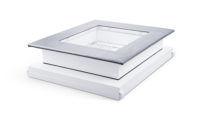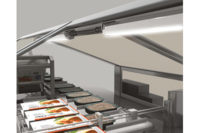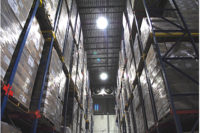When it comes to lighting up a cold food plant, refrigerated and frozen food processors encounter a wave of challenges. Simply opting for lower lights to save on electricity costs doesn’t cut it anymore.
Thankfully today’s lighting suppliers provide a host of solutions ideal for any type of cold food plant environment.
For example, Boston-based Digital Lumens answers the needs for more energy-efficient lighting with Intelligent LED Lighting Systems. These LED-based
|
Helpful Hints What are some things refrigerated and frozen food producers need to keep in mind when selecting and installing energy-efficient lighting solutions? 1. Lower wattage equals lower output. Keep in mind that the upfront cost of a lighting system is the least significant component of a lighting system, advises Chris Covell, president of SmartWatt Energy, Ballston Lake, N.Y. “It is important to look at a life-cycle cost of 10-15 years with lighting,” Covell says. “The simple payback on SmartLighting projects in new construction is around one year and two to three years on existing facilities. Utility incentives can be higher for LEDs and advanced controls than energy-efficient fluorescent or traditional/basic motion controls, which further helps to reduce the overall cost of this technology upgrade.” 2. Obtaining total cost of ownership (TCO). “My advice is to work with a trusted resource who is knowledgeable about high-quality LED options and develop a thorough business case that factors project cost, anticipated 5-year energy costs of all lighting types, 5-year maintenance expense, available project incentives or rebates (from local utility) and EPAct credits,” urges Allison Parker, director of marketing for Digital Lumens, Boston. “While LEDs have a higher up-front cost than legacy lights, intelligent LEDs, which use much less energy than even plain LEDs, offer such dramatic energy savings that their five-year TCO is dramatically lower in most environments. Further, intelligent lighting systems provide the ability to fine-tune system settings to match evolving needs.” 3. Meet the necessary standards. In addition, make sure lighting systems are listed on the DesignLights Consortium’s (DLC) Qualified Products List. “Products on the QPL have met the standards necessary (UL listing and full disclosure of all LED lifetime performance data), ensuring that these products are eligible for rebates by utilities that use the QPL as a guide,” Parker says. |
fixtures are said to regularly reduce lighting energy use by up to 90%, while improving light levels, eliminating maintenance and adding better control, says Allison Parker, director of marketing.
“By providing light when operators are in the area and automatically turning off or dimming lights to desired output levels when the area is vacant, the system maximizes efficiency,” she says. “In addition, the LightRules lighting management software gathers data from the Digital Lumens fixtures and provides detailed reports on lighting system metrics (energy use, energy cost, occupancy and more, by aisle, zone, room or facility-wide), and provides the ability to fine-tune lighting settings via software rather than via scissor lift.”
These systems come in 13,000, 18,000 and 26,000 lumen versions, offer instant-on capabilities and perform well in chilled environments (as low as -40°F). Plus, they use less power than traditional high-bay lights, dramatically reducing thermal load, Parker says.
“Because they are only on a fraction of the time, there is less wasted heat from unnecessary light,” she adds.
Meanwhile, SmartWatt Energy, Ballston Lake, N.Y., provides SmartLighting, a combination of LED lighting and advanced control systems.
“LED is quickly becoming the primary and best lighting solution for refrigerated and frozen food processors,” says Chris Covell, president. “It is the only type of light that can be turned on and off instantly, which results in large savings over traditional high-intensity discharge (HID) fixtures. With the evolution of LED lighting, the light source has become more efficient and the cost has dropped, making it an even more attractive option for this application.”
One benefactor of advanced controls is that they operate however they are set when installed. This means that web-based controls, for instance, can easily be changed as needs change for the plant.
“An example is a warehouse aisle within a food processing facility—a traditional motion control would turn off after 20 minutes of inactivity, but with advanced controls, the plant engineer could view usage logs and adjust the control to best function with actual usage patterns,” Covell says. “When this level of granular control is spread out across an entire facility, the results can be dramatic. There is really no better way to save energy than to turn energy using equipment off.”
SolarOne Solutions, Inc., Needham, Mass., introduced a stand-alone lighting system for commercial pathways. The Solo platform features a stainless-steel mounting and luminare design coupled with a support package to make solar-powered lighting more accessible. Plus, the system works autonomously without depending on a grid or any outside wiring.
The future is bright
Despite rising energy costs, the future for LED lighting is bright.
“Lighting in cold facilities is no longer an expensive nuisance based on the 100-year-old Edison light bulb,” says Parker. “Instead, intelligent LED systems deliver
maintenance-free performance, flexibility, insight and control to help optimize overall facility operations, and a rapid payback driven by the exceptional levels of efficiency. Definitely a fundamental shift in how facility managers think about lighting.”
Plus, the energy needed to operate and the cost to maintain continue to rise, forcing refrigerated and frozen food processors to find more cost-effective means of lighting their facilities.
“We see the future of lighting being where every fixture is LED with 0-100% dimming control, of which all of the fixtures will be tied into a web-based energy management system throughout each facility, then rolled out throughout an entire portfolio of buildings,” says Covell. “This would allow a centralized engineering manager to schedule lights and groups of lights across all facilities, allowing for dimming at times of day, lights off at other times of day, etc.”
Gone are the days of the Edison lightbulb. Today’s cold food plants are aglow with some cutting-edge, cost-efficient lighting systems.





